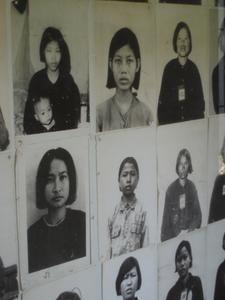Advertisement
Published: July 23rd 2006

 Tuol Sleng
Tuol Sleng
These mugshots fill nearly five rooms.Until 1975, located in a quiet street away from the cacophonous centre of Phnom Penh, was the Tuol Svay Prey High School. After their capture of Phnom Penh in 1975, the Khmer Rouge, having cleared the city of virtually all its habitants (sending them away to work in the rice fields), turned this otherwise ordinary-looking school into a prison. The rebaptised the place S-21 - "Security Prison-21". Here, over four horrific years, the Khmer Rouge imprisoned thousands of perceived enemies of the Revolution. The prison gates saw between 16,000 and 20,000 inmates on their way in. Only seven people came out. The classrooms of Tuol Svay Prey were turned into torture chambers.
When the Vietnamese Army entered Phnom Penh in 1979 having toppled the Khmer Rouge "government", a team of Army photographers stumbled upon the buildings by accident. There, in the ground floor classrooms, they found the remains of several prisoners, shackled to iron bedframes. All had evidently been tortured to death. The photographs taken by that Vietnamese team in 1979 are on display on the walls of the classrooms where the bodies were found. The bedframes, shackles, sticks, electric wire and car batteries used by the Khmer Rouge as
torture instruments still lie on the floor, silently rusting.
Thus Alex and I spent a morning in S-21, now the Cambodian Genocide Museum. The object of several documentary films, S-21 is quite well known. But nothing can prepare you for the sight of these photographs. Nor for those of the thousands of people who were brought here to be killed - row upon row upon row of mugshots, taken by the Khmer Rouge (who were bizarrely meticulous in their record-keeping. All stare vacantly into the distance, some with identification numbers safety-pinned to their collars. Many must have known they would die - walking past these photographs is nearly unbearable. There are elderly men, women, young children. Amongst the countless thousands of Cambodians are scattered a dozen foreigners. They didn't come out, either.
S-21 receives a hundred or so visitors a day. Even at its busiest the place is shrouded in complete silence. What can be said ?
If I had had the misfortune of being Cambodian during those fateful years, it dawns upon me, I would have been a prime target for "destruction", as the Khmer Rouge put it. A foreign parent, a university degree, speaking a

 Tuol Svay Prey High School
Tuol Svay Prey High School
It isn't hard to picture these buildings filled with schoolchildren. The perversity of what was to happen here is hard to imagine.foreign language. One of these would have been excuse enough. Wearing glasses was enough to get you branded a "capitalist parasite" in 1975 Cambodia. The thought sends a shiver down the spine.
A visit to S-21 makes for an uncomfortable few hours. The graphic Vietnamese photographs aside, it is the looks on the faces of the prisoner mugshots that are the most difficult to endure. But to visit Phnom Penh without going to S-21 seemed disrespectful towards Cambodians, both those staring at us from the photographs and those walking around us in the street.
The very same day of our visit, Ta Mok, of the only two Khmer Rouge leaders in custody, died.
Advertisement
Tot: 0.063s; Tpl: 0.01s; cc: 6; qc: 24; dbt: 0.0453s; 1; m:domysql w:travelblog (10.17.0.13); sld: 1;
; mem: 1mb

 Tuol Sleng
Tuol Sleng
 Tuol Svay Prey High School
Tuol Svay Prey High School